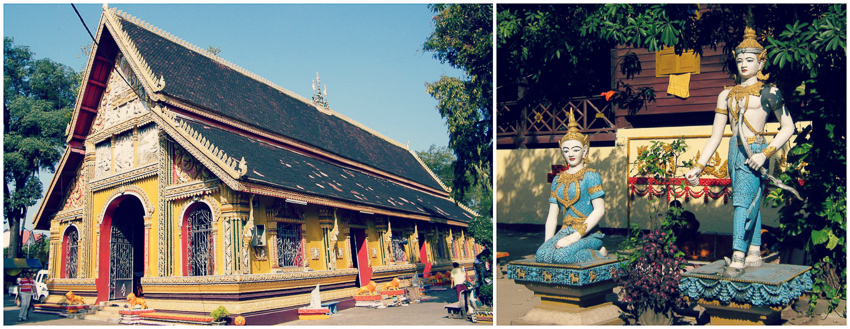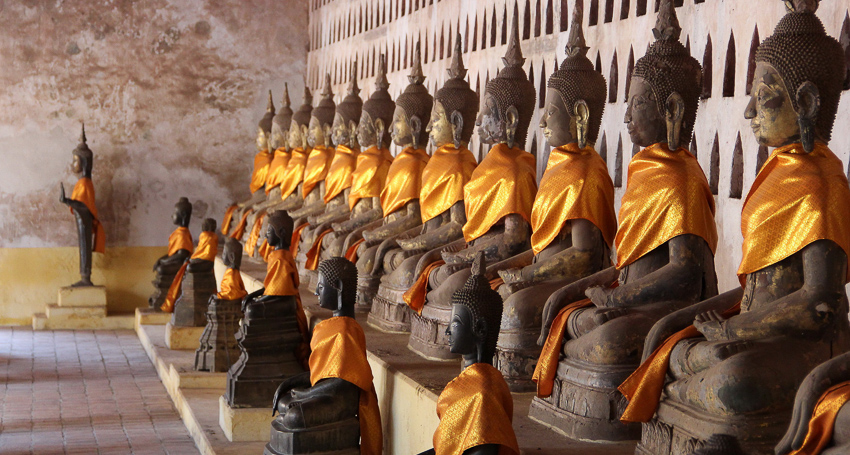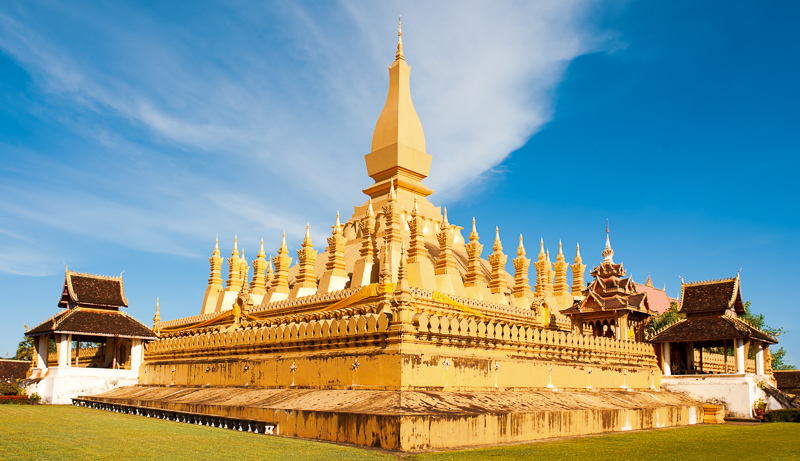Most people tend to skip Vientiane and head straight to Vang Vieng or Luang Prabang. But if you’re passing through Vientiane, or applying for visa (to Thailand or other Asian countries), don’t pass up on the chance to explore this Lao capital dotted with French colonial architecture.
This guide will show you the highlights of the things you can do and places to see in Vientiane. I will chronicle what I did in Vientiane, which was my first stop in Laos during an 11-Day backpacking trip with my cousins. (They had backpacks, I brought my carry-on spinner luggage with me :P)
Getting to Vientiane From the Thai-Laos Border
We arrived in Laos through the sleeper train from Ayutthaya to Nong Khai, and then shuttle train to Thanaleng. We took a minivan from Thaneleng to our hotel. I can’t seem to remember if there are any ATMs inside Thanaleng station — it’s quite a small station. Thankfully, the minivan did accept Thai Baht bills, and we agreed on 200Baht each. The journey to Vientiane took about 20 minutes.
After checking in to our hotel, getting stuff (like Lao data sim), booking our tickets to Vang Vieng for the next day, we went out to explore Vientiane.
Since we were fresh out of Bangkok, we’ve had enough temples for now. We weren’t keen on temple-hopping just yet, so we went to see spots that are (somewhat) unique to Laos.
First stop, Buddha Park!

We went there first as it was bit outside of Vientiane (it’s actually nearer to Thanaleng Station). We took the 1-hour bus ride to Buddha Park (costs 6,000 Kip each way). Download the “Lao Bus Navi” app as they have real-time bus data — helpful when making your way back to Vientiane.
This park has over 200 sculptures not just of Buddha, but other deities from Buddhist and Hindu beliefs. A big reclining Buddha lies near the entrance.
It’s easy to get fascinated by the different images, in various sizes, shape and form. We probably spent about 2-3 hours there. Even though its a small sculpture park, it’s not too crowded as people tend to congregate in one place (with the giant pumpkin being the most famous one).
Patuxai Victory Monument — the ‘Arc de Triomphe’ of Asia
 After heading back to Vientiane, we decided to explore the city, on foot.
After heading back to Vientiane, we decided to explore the city, on foot.
From the bus station in Talat Sao, we walked to Lane Xang Avenue, the main avenue. It takes about 10 minutes to walk to the Patuxay Monument, which sits right at the entrance of Patuxay Park.
It reminded me of Arc de Triomphe in France, though this one is much smaller. This victory arch was actually inspired by the French ‘Arc de Triomphe’, but the Patuxai has Laotian designs incorporated as well.
As it was already late afternoon, we didn’t go up there (which you can). We just took lots of pictures! 🙂 If you want panoramic views of the city, take time to climb up the arch.
TIP: Go inside Patuxay Park, there’s a big pond there which you can make your photos look more stunning.
From there, we took a tuktuk to the Vientiane Night Market right along the riverside.
Vientiane Night Market
This one is HUGE!
The market starts to open around 5:30pm. And it’s right along the bank of Mekong River. Food, souvenir items, scarves are just some of the things you can find here. Lots of locals frequent this market, not just the tourists.
Cheap eats and street food dot the road that runs alongside the night market.
Similar to Thai food, Lao food tend to be spicy. I forgot about that and ordered something which turned out to be really spicy.. so I rushed to find a milky drink to ease the spiciness. Bad move, since I drank beer just before. I ended up with an upset tummy, so had to go home ahead of my cousins. They both came back with some nice finds.. one of which is a silk scarf/shawl, which proved to be really useful as the weather was getting cooler as we move our way up to Northern Laos.
Feel like you can do more in 1 day?
If you look at our itinerary and think you can probably squeeze in a couple more stops, you most definitely can. This was just in the beginning of our 11-day trip so we didn’t want to exhaust ourselves and just chose a few places to visit 😉
Had we just dropped our bags at the hotel and left, we could’ve added 2-3 hours more to explore in the morning. That’s more than enough time to see the different wats (temples) in Vientiane, which is within walking distance (or a short tuktuk ride) from each other.
Other Vientiane Attractions Worth Visiting
There are definitely more to see in Vientiane than what I’ve outlined above, although visiting them all would be impossible.
I’ve annotated a Google Maps map of Vientiane below to show you how near the attractions are to each other.
Vientiane Map – Guide for Tourists

Vientiane Wats / Temples:
These 3 most popular wats are within a short walking distance from each other. If you start the furthest temple, Wat Si Muang, then walk for about 15mins. to Wat Phra Kaew, which is just about 5mins. walking distance to Wat Si Saket. You’ll finish visiting all 3 wats in 2-3 hours, if you do it that way.
Wat Sisaket is also near to the “morning market” bus station, where you can ride the bus going to Buddha Park.
1. Wat Si Muang

Wat Si Muang – Photo by Philip Roeland | CC BY-NC-ND 4.0
Don’t let its appearance fool you. This humble temple hides a rich history behind its unremarkable facade.
This temple was named after Si Muang, a young woman who sacrificed herself to appease angry spirits while the temple was being built. The original Wat Si Muang was built in 1563, but it was destroyed when Siam invaded in 1800s. The temple you now see today was built in 1900s.
Wat Si Muang is an important place of worship for the majority Buddhist Lao people, and is revered as the ‘mother temple’ of Vientiane.
2. Wat Ho Phra Keo

Haw Phra Kaew Temple, Vientiane, Laos
Loosely translated to “Altar of the Emerald Buddha“, Ho Phra Kaew was built in 1565 to house the Emerald Buddha. The Siamese reclaimed it in 1778 and the Emerald Buddha now sits in Wat Phra Kaew next to the Grand Palace in Bangkok.
This temple is not used for religious activities anymore, and is now a museum. It is located right next to the Presidential Palace in Vientiane.
3. Wat Si Saket

Buddhas inside Wat Si Saket, Photo by Pietro Ferreira | CC BY-NC-ND 4.0
Being one of the few temples which survived the Siamese-Lao War of 1828, Wat Sisaket is famous for its thousands of Buddha images carved in wood, stone and bronze, all dating back to 1500s up to 1800s.
Pha That Luang — The Great Stupa

Pha That Luang stupa in Vientiane, Laos. The most important national monument in Laos.
A national symbol of Vientiane, this huge stupa is not just golden in color but is actually literally covered in gold! It was built in 1566 by the then King Setthathirat when he moved the capital of Laos from Luang Prabang to Vientiane.
Translated into “Great Golden Stupa”, Pha That Luang is considered as one of best Buddhist architectural work in the world. It is bordered by 2 temples: Wat That Luang Neua (in the north) and Wat That Luang Tai (in the south).
Located about 5km from the center of Vientiane, you can easily get here by TukTuk. Allot about 1-2 hours in your itinerary if you’re planning to visit Pha That Luang and the 2 temples.
Visiting Vientiane soon?
I hope this guide has helped you craft your Vientiane itinerary. If you’ve been to Vientiane, or planning to visit to soon, drop a comment below and tell me what you loved about this Lao capital. Looking forward to hear from you! 🙂
Cover Photo By Mish Abalos. Used with permission.


4 comments
[…] Destinations […]
[…] Destinations […]
your blogs are very detailed and thorough. thanks for all the info which will help me to plan my trip. Previously I was concerned about including Laos in my itinerary due to time constraints but your guidance shows me its very convenient to do so.
Hi Toni, glad to help!
-Gie